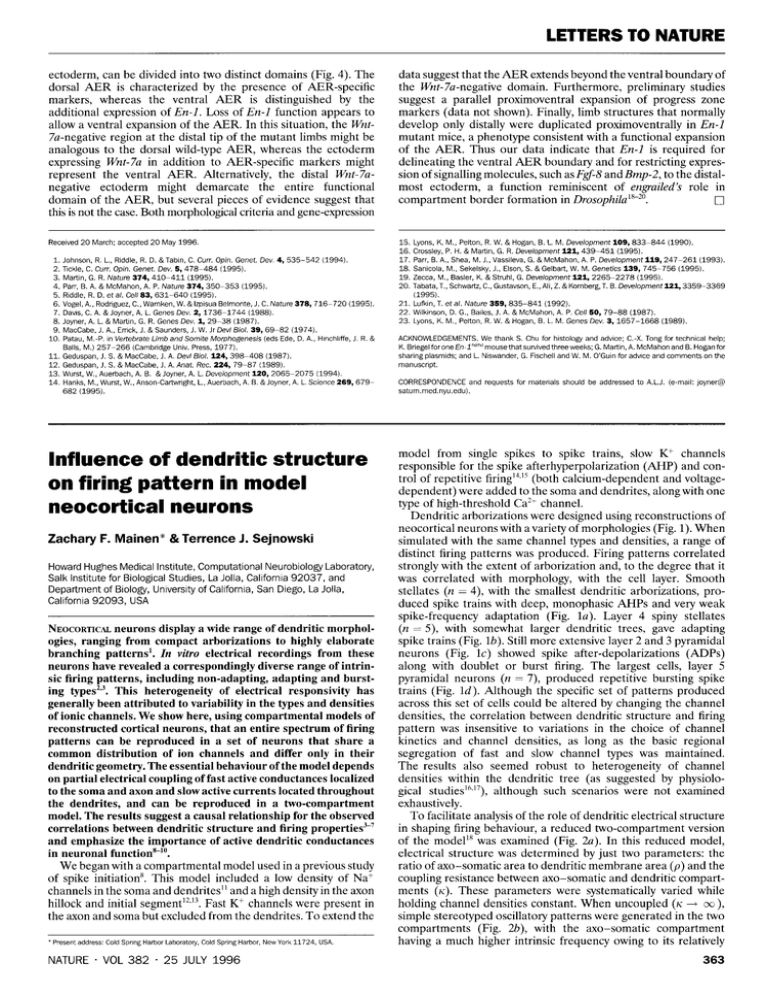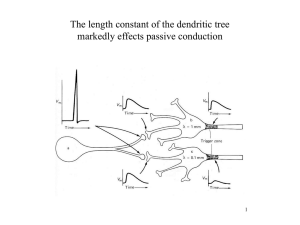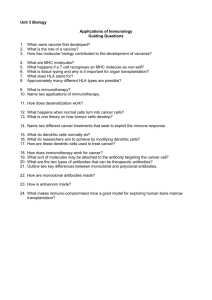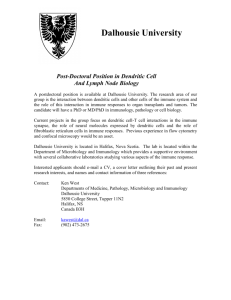LETTERS TO NATURE
advertisement

LETTERS TO NATURE
ectoderm, can be divided into two distinct domains (Fig. 4). The
dorsal AER is characterized by the presence of AER-specific
markers, whereas the ventral AER is distinguished by the
additional expression of En-I. Loss of En-1 function appears to
allow a ventral expansion of the AER. In this situation, the Wnt7a-negative region at the distal tip of the mutant limbs might be
analogous to the dorsal wild-type AER, whereas the ectoderm
expressing Wnt-7a in addition to AER-specific markers might
represent the ventral AER. Alternatively, the distal Wnt-7anegative ectoderm might demarcate the entire functional
domain of the AER, but several pieces of evidence suggest that
this is not the case. Both molphological criteria and gene-expression
data suggest that the AER extends beyond the ventral boundary of
the Wnt-7a-negative domain. Furthermore, preliminary studies
suggest a parallel proximoventral expansion of progress zone
markers (data not shown). Finally, limb structures that normally
develop only distally were duplicated proximoventrally in En-I
mutant mice, a phenotype consistent with a functional expansion
of the AER. Thus our data indicate that En-1 is required for
delineating the ventral AER boundary and for restricting expression of signalling molecules, such as Fgf-8 and Bmp-2, to the distalmost ectoderm, a function reminiscent of engrailed's role in
0
compartment border formation in D r o s ~ p h i l a ~ ~ - ~ ~ .
Rece~ved2 0 March; accepted 2 0 May 1 9 9 6
15. Lyons, K. M., Pelton, R. W. &Hogan, 8. L. M. Deveiopment 109,833-844 (1990).
16. Crossley, P. H. & Mart~n.G. R. Deveioprnent 1 2 1 , 4 3 9 - 4 5 1 (1995).
17. Parr, B. A., Shea, M. J., Vasslleva, G. & McMahon, A. P. Development 119,247-261 (1993).
18. Sanlcola, M., Sekelsky, J., Elson, S. &Gelban, W. M. Genetics 139, 745-756 (1995).
19. Zecca, M., Basler, K. & Struhl, G. Deveiopment 121, 2265-2278 (1995).
20. Tabata,T., Schwartz, C., Gustavson, E., All, Z. & Kornberg,T. B. Deveiopment 121,3359-3369
(1995).
21. Lufk~n,T. e t al. Nature 359, 8 3 5 - 8 4 1 (1992).
22. W~lk~nson,
D. G., Ba~les,J. A. & McMahon, A. P. Cell 50, 79-88 (1987).
23. Lyons, K. M., Pelton, R. W. &Hogan, B. L. M. Genes D e v 3, 1 6 5 7 - 1 6 6 8 (1989)
1.Johnson, R. L., Rlddle, R. D. &Tabln, C. Curr. Opin. Genet. Dev. 4, 535-542 (19941.
2. Tlckle, C. Curr. Opin. Genet. Dev. 5, 478-484 (1995).
3. Mart~n.G. R. Nature 3 7 4 , 4 1 0 - 4 1 1 (1995).
4. Parr. B. A. & McMahon, A. P. Nature 374,350-353 (1995).
5. R~ddle.R. D. et ai. Cell 83, 631-640 (19951.
6. Vogel, A,, Rodr~guez,C., Warnken, W. & lzplsua Belmonte, J. C. Nature 378, 716-720 (1995).
7. Davls, C. A. & Joyner, A. L. Genes Dev. 2, 1736-1744 (19881.
8. Joyner, A. L. & Marun, G. R. Genes Dev. 1
,29-38 (1987).
9. MacCabe. J. A,. Err~ck.J. & Saunders, J. W. Jr Devi Biol. 39, 69-82 (19741.
10. Patau, M.-P. In Veftebrate LimbandSomite Morphogenesis (eds Ede, D. A,. Hlnchllffe, J R. &
Balls, M.) 257-266 (Carnbrldge Unlv. Press, 1977).
11.Geduspan, J. S. & MacCabe, J. A. Devl Bioi. 124,398-408 (1987).
12. Geduspan, J. S. & MacCabe, J. A. Anat. Rec. 224,79-87 (19891.
13. Wurst, W., Auerbach, A. 8. & Joyner, A. L. Deveioprnent 120,2065-2075 (1994).
1 4 . Hanks, M., Wurst, W., Anson-Cariwrlght. L., Auerbach, A. B. & Joyner, A. L. Science 269,6796 8 2 (1995).
Influence of dendritic structure
on firing pattern in model
neocortical neurons
Zachary F. Mainen* & Terrence J. Sejnowski
Howard Hughes M e d i c a l Inst~tute,
C o m p u t a t i o n a l N e u r o b i o l o g y Laboratory,
Salk I n s t i t u t e for Biological Studies, La J o l l a , Cal~forn~a
92037, and
Department of Biology, Un~vers~ty
of Californ~a,San D i e g o , La Jolla,
C a l i f o m l a 92093, USA
N E O C O R Tneurons
IC~
display a wide range of dendritic morphologies, ranging from compact arhorizations to highly elaborate
branching patterns'. In vitro electrical recordings from these
neurons have revealed a correspondingly diverse range of intrinsic firing patterns, including non-adapting, adapting and bursting typeszy3.This heterogeneity of electrical responsivity has
generally been attributed to variability in the types and densities
of ionic channels. We show here, using compartmental models of
reconstructed cortical neurons, that an entire spectrum of firing
patterns can be reproduced in a set of neurons that share a
common distribution of ion channels and differ only in their
dendritic geometry. The essential behaviour of the model depends
on partial electrical coupling of fast active conductances localized
to the soma and axon and slow active currents located throughout
the dendrites, and can be reproduced in a two-compartment
model. The results suggest a causal relationship for the observed
correlations between dendritic structure and firing properties3-"
and emphasize the importance of active dendritic conductances
in neuronal function"'.
We began with a compartmental model used in a previous study
of spike initiation8. This model included a low density of Na+
channels in the soma and dendrites" and a high density in the axon
. ' ~Kt
. channels were present in
hillock and initial ~ e ~ m e n t ' ~Fast
the axon and soma but excluded from the dendrites. To extend the
* Present address' Cold Sprlng Harbor Laboratory, Cold Sprlng Harbor. New York 11724. USA
NATURE . VOL 382 . 25 JULY 1996
ACKNOWLEDGEMENTS. We thank S. Chu for h~stologyand adv~ce;C.-X. Tong for techn~calhelp;
K. Brlegel for one En~l"'hdmousethatsurvlved threeweeks; G. Martln, A. McMahon and B. Hogan for
sharlng plasmlds; and L. Nlswander, G. Flschell and W. M. O'Guln for advce and comments on the
rnanuscnpt.
CORRESPONDENCE and requests for rnaterlals should be addressed to A.L.J. (e-mall: joyner@
saturn.rned.nyu.edu).
model from single spikes to spike trains, slow K+ channels
responsible for the spike afterhyperpolarization (AHP) and control of repetitive firingI4.l5(both calcium-dependent and voltagedependent) were added to the soma and dendrites, along with one
type of high-threshold Ca2- channel.
Dendritic arborizations were designed using reconstructions of
neocortical neurons with a variety of morphologies (Fig. 1). When
simulated with the same channel types and densities, a range of
distinct firing patterns was produced. Firing patterns correlated
strongly with the extent of arborization and, to the degree that it
was correlated with morphology, with the cell layer. Smooth
stellates (n = 4), with the smallest dendritic arborizations, produced spike trains with deep, monophasic AHPs and very weak
spike-frequency adaptation (Fig. la). Layer 4 spiny stellates
(n = 5 ) , with somewhat larger dendritic trees, gave adapting
spike trains (Fig. lb). Still more extensive layer 2 and 3 pyramidal
neurons (Fig. lc) showed spike after-depolarizations (ADPs)
along with doublet or burst firing. The largest cells, layer 5
pyramidal neurons (n = 7), produced repetitive bursting spike
trains (Fig. Id). Although the specific set of patterns produced
across this set of cells could be altered by changing the channel
densities, the correlation between dendritic structure and firing
pattern was insensitive to variations in the choice of channel
kinetics and channel densities, as long as the basic regional
segregation of fast and slow channel types was maintained.
The results also seemed robust to heterogeneity of channel
densities within the dendritic tree (as suggested by physiological studies'""), although such scenarios were not examined
exhaustively.
To facilitate analysis of the role of dendritic electrical structure
in shaping firing behaviour, a reduced two-compartment version
of the model1' was examined (Fig. 2a). In this reduced model,
electrical structure was determined by just two parameters: the
ratio of axo-somatic area to dendritic membrane area ( p ) and the
coupling resistance between axo-somatic and dendritic compartments ( K ) . These parameters were systematically varied while
holding channel densities constant. When uncoupled (K + cc ),
simple stereotyped oscillatory patterns were generated in the two
compartments (Fig. 2b), with the axo-somatic compartment
having a much higher intrinsic frequency owing to its relatively
LETTERS TO NATURE
rapid channel kinetics. When the dendrite and axon-soma were
which interaction between I,, and I , gave rise to bursts (not
fully coupled (K + 0), alteration of p affected the size of AHP and
shown).
To relate the reconstructed multicompartmental models back
the amount of spike-frequency adaptation, but produced a limited
to the reduced model we examined their electrotonic structure in
set of firing properties (Fig. 2c).
more detail (Fig. 4). The neurons examined varied widely in both
Aweak to moderate coupling strength was necessary to produce
their dendritic membrane area and the degree of electrical
the full range of firing patterns, including spike bursts and ADPs.
attenuation between soma and dendrites. This can be seen in
With such partial coupling, small changes in p or K produced
histograms of the steady-state electrical impedances between
dramatic changes in firing pattern (Fig. 2 4 e). Dendritic Na+
channels were critical to the generation of bursts and A D P S ~ , ' ~ , soma
~ ~ and dendritric compartments (see Fig. 4 legend). This
metric is analogous to the parameter K of the two-compartment
(Fig. 3a-c). These channels promoted propagation of spikes from
the axon-soma into the dendrite, by prolonging the depolarizamodel. Fast non-adapting spiking occurred for neurons with the
tion following a spike2'. After the soma and axon had repolarized,
smallest dendritic area and transfer impedances; adapting spike
current returned from the dendrite to produce a late depolarizing
trains accompanied moderate dentritic area and transfer
transient (the ADP), with somatic spike bursts occuring when
impedance; and bursting was associated with the largest dendritic
ADPs were above thresholdz2. Decreasing K or p suppressed
area and transfer impedances. These findings are consistent with
bursting and ADPs by reducing the delayed depolarization assocomparisons of electrical structure of 'thick' (bursting) and
ciated with the dendritic spike (Fig. 3d, e). In addition, factors that
'slender' (non-bursting) layer 5 cellsz3and with similarities in the
affected the amplitude and duration of the dendritic spike,
developmental time course of electrical structure and electroincluding the degree of Na+-channelinactivation and the strength
physiological properties of neocortical neuronsz4.
of dendritic K+ currents, similarly affected bursting and ADPs.
Our results demonstrate that the electrotonic structure of a
Thus, dendritic Ca2+ channels could both increase (directly
neuron shapes the dynamic interactions between non-uniformly
through their depolarizing current) and decrease (indirectly by
distributed ion channels, and may thereby control the pattern of
activating Ca2+-dependentK+ channels) these phenomena. Howrepetitive firing and the interspike membrane-potential trajectory.
Heterogeneity of dendritic structure can thereby explain several
ever, the effects of electrical structure on firing pattern and
voltage trajectory were not strictly dependent on Ca2+,as similar
aspects of the heterogeneous firing properties of neocortical
results could be obtained with a channel set lacking I,, and I,,,, in
neurons parsimoniously in terms of their anatomical variety.
FIG. 1Distinct firing patterns in model neurons with identical channel
distributions but different dendritic morphology. Digital reconstructions of
dendritic arborizations of neurons from rat somatosensory cortex (a) and
cat visual cortex (b-d). a, Layer 3 aspiny stellate. b, Layer 4 spiny stellate.
c, Layer 3 pyramid. d, Layer 5 pyramid. Somatic current injection (50, 70,
100, 200 pA for a-d, respectively) evoked characteristic firing patterns. a
shows only the branch lengths and connectivity whereas b-d show a twodimensional projection of the three-dimensional reconstruction. Scale
bars: 250 pm (anatomy), 100 ms, 25 mV.
METHODS. Standard compartmental modelling techniquesz6were used to
simulate spatially extended neurons with passive electrical structure, four
voltage-dependent currents: fast Na+, I,, (refs 8,27); fast KA,,I (refs 8,
27); slow non-inactwatingK+,,I (ref. 28); and high-voltage activatedCa2+,
I,, (ref. 29) and one Ca2+-dependentcurrent, I,,, (ref. 30). All dendrltic
branches were divided into cylindrical compartments with a maximum
length of 50pm. The dendritic membrane area of spiny neurons was
increased to account for spines (adding 0.83 pm2 per linearpm of dendrite). An axon, which was not present in the reconstructed anatomy, was
attached to the soma of each cell8. The axon consisted of a conical hillock
(10 pm long), tapering to one-quarter width to a cylindrical initial-segment
region (15 pm) followed by 5 myelinated internodes (100 pm) separated by
nodal segments. We took into account an observed correlation between
soma diameter and initial segment diamete?, by scaling the initial
segment diameter as a function of the soma area. All currents were
calculated using conventional Hodgkin-Huxley-style kinetics with an integration time step of 250 ps. Current (I) from each channel type was given by
I= gaxb(v - E), wheregisthe local conductancedensity, a isan activation
variable with x order kinetics, b is an optional inactivation variable, v is the
local membrane potential, and E is the reversal potential for the Ionic
species (E = -70 mV, E, = -90 mV, EN, = 5 0 mV, E,, = 140 mV).
Internal calcium concentration was computed using entry via I,, and
removal by a first order pump: d[Ca2+],/dt= ( - 1 x l o 5 x 1,,/2F)([Ca2+],- [Ca2+],)/zR, where [Ca2+], = 0.1 pM, and zR = 200 ms.
Channel activation and inactivation variables were expressed in terms of
a steady state value, a, (v), and a time constantz,(v) which were calculated
from a first-order reaction scheme with forward rate cc and backward rate p,
givinga, (v) = a/(cc(v) p(v)), T, = 1/(a p). The specific rate functions
for each current were I,, activation (x = 3): a = 0.182(v 25)/
inactivation:
( 1 - e-("+25)/9),p = -O.l24(V + 25)/(1 - E(v+25'/9);INa
0.75 pFcm-2 (except myelinated axon segments, where C, =
r = 0.024(v + 4 0 ) / ( 1 - e-(v+40)/5),B = - 0 . 0 0 9 1 ( ~ 65)/(1e("+65'/5),
0.02 pFcm-'). Specific membrane resistance (R,) was 3 0 kR-cm2
(except axon node segments, where R, = 5 0 R - cm2). Specific axial
b x = 1 / ( 1 + e(V+55)162);
ICa
inactivation (x = 2): a = 0.055(v + 27)/
e-(27+v)i38), p = 0.94e-(vT75)117;I,, inactivation: a = 4.57 x
resistance was 15OR-cm. Conductance densities (in pSpm-') were as
& ~ ~ ( ~ + ~ ~P 1= /0.0065/(1
~ ~ ,
+ e-lv+15)1z8);,I activation (X = 1): follows. Dendrites: g, = 20, g, = 0.3, -g,, = 3, and g, = 0.1. Soma:
a = O.O2(v - 2 5 ) / ( 1 e-(v-251/9),p = -O.O02(v - 25)/ ( 1 - e(v-251/9); as dendrites and in addition g, = 200. Axon hillock and initial segment:
,I
activation (x = 1): a = 1x 10-4(v + 3 0 ) / ( l - e-("+30)!9), 8 =
g
, = 2000, g, = 30,000. Nodes of Ranvier: g, = 30,000. The rates
-l.10-4(v + 3 0 ) / ( 1 - e'v+30)19);lKCa
activation (x = 1): a([Caz+],)=
and conductance densities were developed at 23 "C and were therefore
0.01 x [Ca2+],, p = 0.02. Specific membrane capacitance (C,) was
increased from the values given to 37 "C using a Q,, of 2.3.
,,,,
+
+
+
+
NATURE
. VOL 382 . 25 JULY
1996
LETTERS TO NATURE
FIG. 2 Effects of electrical structure on
U
b Uncoupled (K--)
C
F U I I ~coupled (K-O)
firing pattem in a reduced model. a, A twoP =I40
P =4m
compartment model incorporating the
gleak
same channels modelled in Fig. 1.The
@a
two compartments correspond to the
dendritic tree ('dendrite') and the soma
gca
and axon initial segment ('axon-soma').
&a
The parameter K specifies the electrical
dKm
resistance (coupling) between the two
P =460
P =4&0
cm
compartments. The parameter p specifies the ratio of dendritic to axo-somatic
-a r e a p p j
area som axon)
area and thereby sets the strength of
--.-.
-..-dendritic currents relative to axo-somatic
I
currents. The channels and membrane
properties of each compartment are
Partially coupled (K =lo)
e
Partially coupled (p=190)
d
depicted. b, Uncoupled dendritic (top)
somalaxon
dendrite
somalaxon
dendrite
and axo-somatic (bottom). comwartments
.
(K + 00) are each capable of discharging repetitively when current is
P =I40
injected (top, 400 PA; bottom, 1 0 PA).
Note that the firing frequency of the
axo-somatic compartment, which is
I is much
driven by the fast I,, and ,
higher than for the dendritic compartP =I65
ment, which is driven by ,I ,,I and I,,.
c, When fully coupled (K + O), eliminating electrotonic effects, the amount of
spike-frequency adaptation varies with
the size of the dendritic compartment,
butthe model does not display burstingor
spike ADPs. d, e, Partial coupling
produces voltage gradients between
axo-somatic (left) and dendritic (right)
compartments and supports bursting
and ADPs. When partially coupled,
ment contained just g
, = 1500,g,,=30,000. The compartments were
changes in either dendritic area p (d) or changes in coupling K (e) alter
connected with axial resistance given by the parameter K, which generally
firing pattern to injected current (100 PA, injected in axo-somatic compartment). Scale bar (30 mV, 200 ms) applies to all panels.
ranged from 1to 1 0 MR. The area of the axo-somatic compartment was
METHODS. Compartmental simulations were carried out with channels
100 pmZ and the area of the dendritic compartment was specified as a
multiple (p) of the axo-somatic area, generally 100 to 500. Presence of a
described in Fig. 1. The dendritic compartment properties were: C, =
leak conductance and capacitance in the axo-somatic compartment d ~ d
0 , 7 5 p F ~ m -R
~, , = 3 0 kR - cm2, and active conductances (in pSpm-')
g, = 15, g, = 0.3, ,g = 3, and g, = 0.1. The axo-somatic compartnot affect the results and were therefore omitted for simplicity.
.A
NJJ--.uk
h
FIG. 3 Electrical basis for spike after-depolarization and bursting in the
reduced model. a, All-or-none bursting in a partially coupled two-compartment model (p = 200, K = 10) was triggered by a short current pulse. Just
subthreshold and superthreshold responses are shown. b, The burst could
be suppressed after the first spike when followed by a short hyperpolarizing
pulse. This revealed an underlying depolarizing envelope driven by a
prolonged dendritic spike. c, Reducing the dendritic Na+ conductance by
70% reducedthe width and amplitude ofthe dendritic spike and suppressed
burst generation and the depolarizing potential following the spike. Reducing the electrical coupling K (d, 50% reduction) or the ratio of dendritic to
axo-somatic area p (e, 30% reduction) also substantially reduced the
sustained depolarization. In each panel, voltage of the axon-soma (top)
and the dendrite (centre)and the stimulus (bottom) are shown. In panelsce, the control conditionb is shown in dotted lines for comparison. Scale bars
(20 ms, 3 0 mV, 1nA) apply to all panels.
NATURE
. VOL 382 . 25 JULY 1996
LETTERS TO NATURE
19. Turner, R. W., Malet, L., Deerlnck, T., Levlnson, S. R. & Elllsrnan, M. H. J. Neurosci. 14,64536 4 7 1 (1994).
Azouz, R.. Jensen. M. S. & Yaarl. Y. J. Physioi. 492, 211-223 (1996).
Grant, R., Kernell, D. & Smlth, R. S. J. Physioi. 168, 100-115 (1963).
Kandel, E. R. &Spencer, W. A. J. Neurophysioi. 24,243-259 (1961).
Larkman, A. U., Major, G., Stratford, K. J. &Jack, J. J. El. J. comp. Neurol. 323, 137-152
(1992).
24. Kasper, E. M., Larkman, A. U., Lubke, J. & Blakemore, C. J. comp. Neuroi. 339, 475-494
(1994).
25. Agrnon, A. & Connors, El. W. J. Neurosci. l 2 , 3 1 9 - 3 2 9 (1993).
26. H~nes.M. In Neural Svsterns:Anaivsis and Modeling (ed. Eeckman. F. H.) 127-136 (Kluwer.
Boston, MA, 1993).
27. Harn~ll,0. P., Huguenard, J. R. & Prlnce, D. A. Cerebralcortex 1,48-61 (1991).
28. Gutfreund. Y Yarom. Y. & Sezev. I. J. Phvs~ol.483. 621-640 (1995).
29. Reuven~,I., Fnedrnan, A,, A&,
Y. & ~ u t n l c k M.
, J. J. Neurosci. 13, 4609-4621 (1993)
30. Sloper, J. J. &Powell. T. P. S. Ph~i.Trans. R. Soc. Lond. 8285, 173-197 (1978).
20.
21.
22.
23.
.
ACKNOWLEDGEMENTS. Z.F.M. was supported by an H.H.M.1 predoctoral fellowship. T.J.S. IS
supported by the H.H.M.I.. the N.I.M.H. and the O.N.R. We thank D. K. Smetters, R. Douglas,
K. Martln, El. Connors, L. Caullerand J. Anderson fordendrltlc reconstructions; J. Huguenard,J. Rlnzel
and P. Rhodes for helpful dlscusslons; and A. Oestexhe, G. Brown and R. R~tzfor comments on the
rnanuscrlpt.
CORRESPOhDEhCE ana req lcsrs for mater a s snod a oe adarcsscd to Z.F.M. c-ma : zacn@sal,
ca. . hEcROh coae for thesr s m J a t ons s aia anle e eclron r a at n r t ~ .w . c n sa A m . . Ch..
.
Transfer impedance (Mn)
FIG. 4 Electrical geometry of c o r t i c a l cells. H~stogramsshowthe distribution
of electr~calattenuation between the soma and d e n d r i t i c segments for the
four neurons depicted in Rg. 1.The steady-state transfer impedance
from the soma to each simulated dendr~triccompartment was calculated
by inject~nga small current step (I)in the soma and measuring the
resulting ( p a s s i v e ) s t e a d y - s t a t e voltage change (V) in the dendrit~c
compartment (Z = V I I ) . The histogram bin corresponding to this impedance l e v e l was then ~ncrementedby an amount equal to the membrane
area of that compartment. T h e total area of the histogram therefore reflects
the t o t a l d e n d r i t i c area and the shape of the histogram reflects the r e l a t ~ v e
e l e c t r i c a l distance of the dendrit~cmembrane from the soma. These can be
compared to the parameters p and K in the reduced model, r e s p e c t i v e l y .
(a
Critical role for P7 integrins in
formation of the gut-associated
lymphoid tissue
Norbert Wagner*, Jurgen Lohlert, Eric J. Hunkel$,
Klaus Ley$, Euphemia Leungs, Geoff Krissansens,
Klaus Rajewsky* & Werner Muller*
* Institute for Genet~cs,University of Cologne, 50937 Cologne, Germany
Direct experimental tests of this model could be made by partial
dendritic ablation or manipulationsto alter cytoplasmic resistivity.
As there i s a wide anatomical variety of neocortical dendrites',
our findings support the idea of a continuous spectrum of neocortical firing patterns2,' rather than discrete categories. Differences in spike shape2," passive response properties2', and some
aspects of the time course of adaptation2' observed in vitro were
not readily reproduced in the present model. These limitations
indicate that differences in channel types or intracellular Ca2+
dynamics may also be important. Thus, although the present study
does not exclude contributions of differential channel expression
or other physiological differences, i t supports the hypothesis that
neocortical neurons that share similar channel distributions may
derive functional differentiation from their dendritic morphology.
Similar principles may also apply to other mophologically hetero0
geneous neuronal populations.
Rece~ved1 0 Apr~l;accepted 7 June 1 9 9 6
1.Peters, A. & Jones, E. G. Cerebral Cortex Voi 1: Cellular Components o f the Cerebral Cortex
(Plenum, New York, 1984).
2. McCorm~ck,D. A., Connon, B. W., Llghthall, J. W. & Prlnce, D. A. J. Neurophysioi. 54, 782-806
(1985).
3. Connors, B. W. & Gutnlck, M. J. Trends Neurosci. 13,99-104 (1990).
4. Chagnac-Amltal, Y., Luhrnann, H. J. & Pnnce, D. A. J. comp. Neuroi. 296, 598-613 (1990).
5. Mason, A. & Larkman, A. U. J. Neurosci. 10,1415-1428 (1990).
G Brain Res. 696.
6. Franceschettl. S., Guaneo. E., Panzlca. F.. Sancn, G. E. W. & Avanz~n~,
127-139 (1995).
7. Yang, C. R., Seamans, J. K. &Gorelova, N. J. Neurosci. 16, 1904-1921 (1996).
8. Mamen. Z. F.. Joerces, J.. Humenard, J. R. &Selnowskl, T. J. Neuron 15, 1427-1439 (1995).
W. ~ e u r i 16,
n 701-716 i1996).
9. Yuste, R. &Tank,
10. Rapp. M.. Yarom, Y. & Segev. I. Proc. natn. Acad. Sci. U.S.A. (In the press).
11.Stuart, G. J. & Sakmann, El. Nature 367, 69-72 (1994).
12. Wollner, D. A. & Catterall. W. A. Proc. natn. Acad. SCI. USA. 83,8424-8428 (1986).
13. Angelldes, K. J., Elmer, L. W., Loftus, D. & Elson, E. J. Cell Bloi. 106, 1911-1924 (1988).
14. Schwlndt, P. C. et al. J. Neurophysioi. 59,424-449 (1988).
15. Storm, J. F. Prog. Brain Res. 83,161-187 (1990).
16. Klm, H. G. & Connors. B. W. J. Neurosci. 13, 5301-5311 (1993).
17. Yuste, R., Gutnlck, M. J., Saar, D., Delaney, R. D. &Tank, D. W. Neuron 13, 23-43 (1994).
18. P~nsky,P. F. & Rlnzel, J. J. cornput. Neurosci. 1
,39-60 (1994).
i.
i H e m c h - P e t t e - I n s t i t u t e for
E x p e r i m e n t a l Virology and immunology,
University of Hamburg, 20251 Hamburg, Germany
i D e p a r t m e n t of Biomedical Engmeering, University of Virginla,
C h a r l o t t e s v i l l e , V i r g i n ~ a22908, USA
9 Department of Molecular Medicine, Un~versityof A u c k l a n d , A u c k l a n d ,
New Zealand
IMMUNE
defence against pathogens entering the gut is accomplished by lymphocytes in the gut-associated lymphoid tissue
(GALT), a major compartment of the immune system1. The
GALT, comprising Peyer's patches, lamina propria lymphocytes
and intra-epithelial lymphocytes of the intestine, is populated by
lymphocytes that migrate there from the v a s ~ u l a t u r e Here
~ ~ ~ . we
report that, in mice deficient for the P7 integrin subfamily of
adhesion molecules, the formation of the GALT is severely
impaired. This is probably due to a failure of P7-I- lymphocytes
to arrest and adhere to the vasculature at the site of transmigration into the GALT.
Lymphocytes move through the GALT by means of differential
expression and activation of adhesion molecules4. Emigration of
lymphocytes from the vasculature into tissues requires them to roll
along the endothelial cells, arrest and adhere firmly to endothelial
cells, and migrate across the end~thelium~,~.
The 07 integrin subfamily of adhesion molecules i s expressed on
a subset of lymphocytes, and consists of two members, a4P7 and
aEP7 (refs 7-10): a4P7 mediates the adherence of lymphocytes to
high endothelial venules (HEVs) of Peyer's patches" and has
been implicated in lymphocyte rolling12,and aEP7 mediates the
adherence of intra-epithelial lymphocytes of the intestine (IELs)
to the intestinal epithelium'" In chronic inflammatory bowel
disease, either a4P7 or a4P1, or both, mediates the migration of
lymphocytes into inflammatory lesions". To analyse the contribution of the P7 integrins to the formation of the GALT, and to
determine how P7 integrins participate in the compartmentalization of the immune system, we generated P7-deficient mice.
NATURE . VOL 382 . 25 JULY 1996






